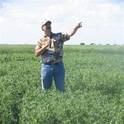
Presentation
Management Strategies to Improve Yield and Nitrogen Use of Spring Wheat and Field Pea in the Semi-Arid Northern Great Plains USA
19th World Congress of Soil Science: Soil Solutions for a Changing World
(2010)
Abstract
Available water and N fertility are primary constraints to crop production in the northern Great Plains of the USA. A field trial was initiated in 2004 to compare four crop rotations in a complete factorial of two tillage and two management systems. Rotations were continuous spring wheat (SW), pea-SW, barley hay-pea-SW, and barley hay-corn-pea-SW. Tillage systems were no till and field cultivator tillage, while management systems were conventional and ecological. Conventional management included broadcast nitrogen fertilizer, standard seeding rates, and short stubble height. Ecological management practices varied by crop, and included banded nitrogen fertilizer for cereals, increased seeding rate, delayed planting date for SW, and taller stubble height. Continuous SW grain yield was 26% lower than SW in more diverse rotations. Pea grain yield was 18% lower in 2-yr rotations than in more diverse rotations. Ecologically managed SW yielded 29% less than conventionally managed SW, presumably due to the delayed planting date. Ecological management of pea resulted in 12% greater yield compared to conventional management. Tillage system rarely impacted crop yield. Yield increases in SW were related to increased N use efficiency.
Keywords
- crop rotation,
- zero tillage,
- nutrient management,
- long term experiment,
- wheat production,
- pea production
Disciplines
Publication Date
2010
Comments
Works produced by employees of the U.S. Government as part of their official duties are not copyrighted within the U.S. The content of this document is not copyrighted.
Citation Information
Andrew W. Lenssen, Brett Allen, Upendra Sainju, TheCan Caesar, et al.. "Management Strategies to Improve Yield and Nitrogen Use of Spring Wheat and Field Pea in the Semi-Arid Northern Great Plains USA" 19th World Congress of Soil Science: Soil Solutions for a Changing World (2010) Available at: http://works.bepress.com/andrew_lenssen/78/
